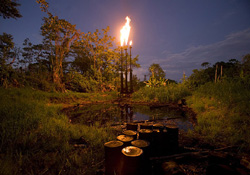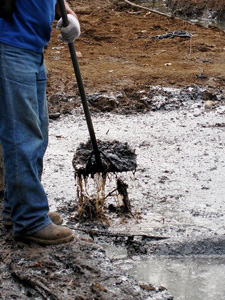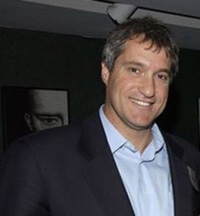Texaco legacy could cost Chevron billions
on
Oil multinationals may face avalanche of claimsTexaco legacy could cost Chevron billions
A local judge in a little town in the Ecuadorian jungle may change the course of corporate history. In the coming months he is set to pass judgement in a multibillion dollar damages suit brought against oil giant Chevron by 30,000 inhabitants of the Amazon rain forest. The Amazonians are claiming $27.3 billion in damages arising from severe environmental pollution. If the claim is upheld, it will be the most costly judgement in an environmental suit ever. And it might pave the way for an avalanche of claims by third world countries against careless multinationals.
 |
| Article Highlights: |
| - In the coming months, an Ecuadorian judge will rule on a court case brought by environmental activists in Ecuador, who claim $27.3 billion in damages from ChevronTexaco, a record amount. - The damages relate to environmental pollution alleged to be caused by Texaco when it operated in the country in the decades between 1964 and 1990. - Although the activists operate from very modest quarters in the Ecuadorian jungle, they are backed by big money and high-powered lawyers from the US. - US Attorney Steven Donziger says he will go to a European or US court to enforce the ruling if it is favourable. - If Donziger succeeds, it could pave the way for activists in “developing” countries across the world to pursue western oil companies for similar cases of pollution in the past. |
Not far from here, in the village of San Carlos, Rosa Morena runs a small medical post. For 25 years she has worked as a nurse in San Carlos. For years the locals used to drink the ground water. Women washed in the river, standing waist deep, and children played in it. Morena recalls how, each morning, oil and chemical tankers would spray the sand roads in the area with polluted waste water to damp down the dust clouds. ‘In those days you couldn’t wear white shoes, because everything went black’, the nurse says. ‘At the time, we thought that dumping oil in the surroundings and on the roads was quite normal. But as time went by more and more people developed disorders. Many became ill and died within months, without having been properly diagnosed. They became very thin, suffered severely from stomach cramps and vomited blood. They probably had cancer, but we don’t know that. Almost every family living round here has been affected.’
Hostile indians
Something went badly wrong with the oil production in the Amazon forest of Ecuador. Production started in the mid-Sixties at two oilfields in the north-east of the country, Sacha and Sushufindi. Several decades previously Shell had already reconnoitred the area, but the oil major withdrew in the late Forties after several of its oil workers were murdered by hostile indians with spears. Twenty years later the US company Texaco took up where Shell had left off. In a joint venture together with state-owned Petroecuador, Texaco pumped some 1.7 billion barrels of oil in the period 1964 to 1990. The Americans owned a minority stake of 40 percent in the joint venture but were solely responsible for the actual oil production. When Texaco exited Ecuador in 1990, it left behind an environmental disaster of epic proportions.
For over twenty years Texaco and Petroecuador operated in the region, allegedly with the use of obsolete technology and little or no regard for the environment. In an area roughly equivalent to a third of Flanders, Texaco discharged 68 billion litres of untreated waste water containing heavy metals and carcinogenic benzine into unlined pits. Environmental activists claim that more than 900 such pits were used and that only a limited number have since been cleaned up. The toxins seeped into the ground and over many years were also discharged directly into waterways through overflow pipes. As a result, say the activists, the soil and ground water have been heavily polluted with carcinogenic toxins, causing hundreds of cancer deaths among the local population. The plaintiffs say this portion of the world’s biggest biosphere has been irreparably damaged while indigenous communities have been decimated or have disappeared completely. Two such indian communities have decamped to the south and now live hidden deep in the rainforests on the Peruvian border.
In Ecuador the blame is considered to rest squarely on Texaco. Petroecuador and the Ecuadorian state deny all responsibility, saying operator Texaco was contractually obligated to protect the environment. The Ecuadorian government, it is claimed, was not in a position to monitor the American oil giant. For close on sixteen years local indian communities and small farmers have been seeking restitution for the damages suffered, aided in their case by radical environmental activists, left-wing politicians and backed by a team of lawyers from Ecuador and the United States. Initially they sued Texaco and subsequently Chevron, the oil giant that acquired Texaco in 2001. Chevron had assumed that Texaco’s Ecuadorian legacy was resolved, thanks to a three-year $45 million clean-up operaton and a 1998 pact with the Ecuadorian state, in which it was agreed to absolve Texaco from further damages claims.
 |
|
Pollution left behind by Chevron |
Modest home
Chevron vigorously contests the report’s conclusions. The company maintains it has cleaned up its share of the environmental damage and points out that after 1990, state oil company Petroecuador continued to operate along the same lines. ‘Chevron is fully aware of the challenges confronting the indigenous inhabitants and is sympathetic to their case’, the company said in a statement. ‘However, Chevron disputes that it is responsible for the problems in the region, that have resulted from the government and [Petroecuador] being unwilling or unable to shoulder their own responsibilities.’ The oil company has pulled out all the stops in a bid to avert a ruling in the plaintiffs’ favour and is lobbying Washington to put pressure on Ecuador. The court in Lago Agrio is expected to hand down judgement by June at the latest.
Some three hundred kilometres west of the oil town of Lago Agrio, in the capital of Quito perched 2900 metres high in the Andes, beats the legal heart of the case against Chevron. From its anonymous base in a modest two-storey house in northern Quito, a team of lawyers, legal assistants and volunteers is preparing the case against the industry titan. Dispersed around the house around twenty of them are at work at their computers, in the meeting rooms or in the archive. Head of the Ecuadorian team for the plaintiffs since 2006 is Pablo Fajardo, a self-made man. He graduated as a lawyer in 2003 after seven years of distance learning from his home in Lago Agrio. ‘Up until 1996 I worked as a cleaner and odd-job man for Petroecuador. I know everything there is to know about the contamination caused by Texaco’, he says.
Fajardo works together closely with right-hand man Luis Yanza within the framework of a small company, Selva Viva. The company receives financial aid from foreign donors, including damages litigation specialists Kohn, Swift & Graf, a Philadelphia-based firm of attorneys with deep pockets and a leading reputation for class actions. Other sponsors of the case listed by US magazine Business Week include ethical investment fund Trillium Asset Management. Trudie Styler, partner of pop musician Sting, also supports the case, though it is not clear whether she provides financial support. ‘Selva Viva was founded to manage the funds needed to bring the case’, Fajardo explains. He says the company has been the target of several attempts by Chevron to discredit the plaintiffs. The company alleges the suit to be a politically motivated attempt to blackmail a Western multinational orchestrated by a corrupt judiciary and driven by a greedy American lawyer and his backers.
Chevron’s suspicions are not entirely unfounded. There is a strong undertow of anti-American sentiment in Ecuador and the country has a radically anti-capitalist environmental movement with a great deal of influence in the case. President Rafael Correa of Ecuador is pursuing a socialist agenda and has professed open support for the plaintiffs. In addition the legal system in Ecuador is known for its corruption. The first judge hearing the case was forced to step down in 2009 after Chevron posted recordings of a bribe attempt on internet it had made with a hidden camera.
Chemical immersion
Not far from the oil well Aguarico 4 in the Sushufindi field a pit measuring some 500 square metres lies hidden among the trees. If you poke the water with a stick the whole surface billows up and down, for the entire area is covered with a thick layer of tar several dozen centimetres thick that is difficult to penetrate. The viscuous black sludge oozes slower than syrup from the stick. The pit is some two metres deep, locals discovered after they spent more than half a day struggling to rescue a horse that had inadvertently fallen in. The animal didn’t survive its chemical dunking. ‘From time to time the pits used to be set alight’, recalls my guide Donald Moncayo (36), who grew up in the rainforest among the boreholes. ‘On those days the sun was blotted out by a thick black smog.’
The first protests by indigenous peoples date back to 1986 in Sucumbios, a province rich in oil. The court case against Texaco in the United States in 1993 encouraged more people to come on board, creating a community movement that hopes to reap the rewards of its perseverance in the near future. Also looking for a reward – and a big one at that – is the US attorney in the case, Steven Donziger. Donziger, who claims to be the main investor in the case along with Kohn, Swift & Graf, regularly flies out to Ecuador from New York. While Fajardo and his activist right-hand man Yanza have regularly garnered international acclaim for their work for the victims of the oil contamination of the Ecuadorian rain forests, Donziger tends to stay out of the limelight. But his role in the United States is crucial. Behind the scenes he’s active in maintaining the flow of funds to finance the class action as well as feeding stories to the US media and politicians so as to keep Chevron on the back foot. Seated in Selva Viva’s modest office in Quito, he pauses to consider his words. ‘I think that we’ve pumped at least $10 million into this case,’ he says finally.
|
Oil in Ecuador Ecuador’s oil reserves are situated in the Amazon rain forest east of the Andes mountain range that cuts the country in half from north to south. Around fifteen different oil companies currently account for a daily production of 530,000 barrels from more than 300 different wells in the forest, making Ecuador the fifth-largest oil producer in South America. The country also currently chairs the organisation of oil-producing countries Opec. Ecuador’s most productive fields are situated in the north east, Sushufindi being the biggest. The oil is transported via two pipelines over the Andes and to the coast. There it’s destined for export or for refining in a vulnerable oil refinery behind the dunes flanking the coastal resort of Esmereldas. Petroecuador is increasingly boosting its share of production and currently produces more than half of the oil in Ecuador. This trend reflects a combination of increasing government intervention in the economy and an exodus of foreign private oil companies. Petroecuador has a poor performance record, which hasn’t improved since the socialist president Rafael Correa placed it under military control. Ecuador is highly dependent on its oil and is attempting to ramp up production with the aid of Venezuela and China.
|
If the case against Chevron is upheld it might have far-reaching consequences – and not only for Chevron. A multibillion dollar damages award would make it easier to finance other court cases against multinationals in third world countries, thereby increasing the likelihood of such claims. The man poised to write history in this case is judge Nicolás Zambrano. The 53-year-old judge looks a bit like the American actor Telly Savalas (Kojak) in his heyday. Zambrano works from the offices of the provincial court of Sucumbios, situated above a shopping centre on Lago Agrio’s busy main street. On his desk lies one of the latest dossiers on the case, in a pink file. Zambrano denies any political involvement in the case. One floor up, in a small courtroom on the second floor overlooking the Amazon forest on the town’s outskirts, he will pass the judgement that could send Chevron’s stock price tumbling. But his hands won’t betray the slightest tremor. ‘It’s not a case that keeps me awake at night’, he says, looking his visitor straight in the eye: ‘no me quite el sueño’.
|
Q: Why have you totally ignored the role played by state oil company Petroecuador? After all, it had a controlling stake in the consortium and after Texaco pulled out it conducted operations in precisely the same way as before. And why is the Ecuadorian state being let off the hook? The government here reaped significant benefits from the cheap way the oil was pumped out of the ground.
Q: Why Europe? Q: What sort of effect will a ruling against Chevron have? Q: Other consequences? Q: I get the impression that Chevron will still try and find a way out through negotiation. Maybe the company will be prepared to forge a last-minute compromise, provided Ecuador also shoulders some of the responsibility. Do you consider that likely? |



Discussion (0 comments)